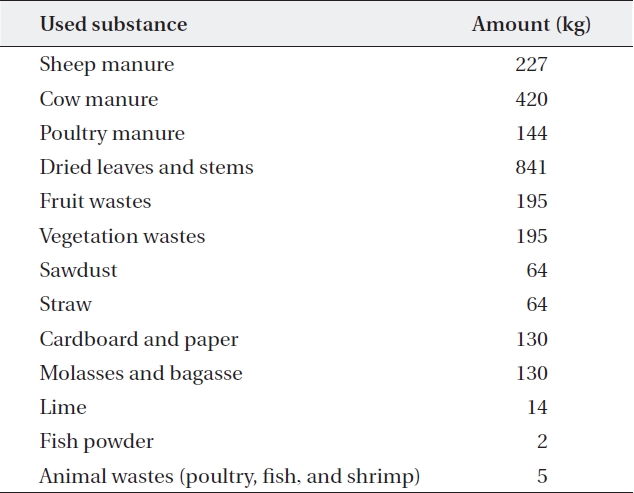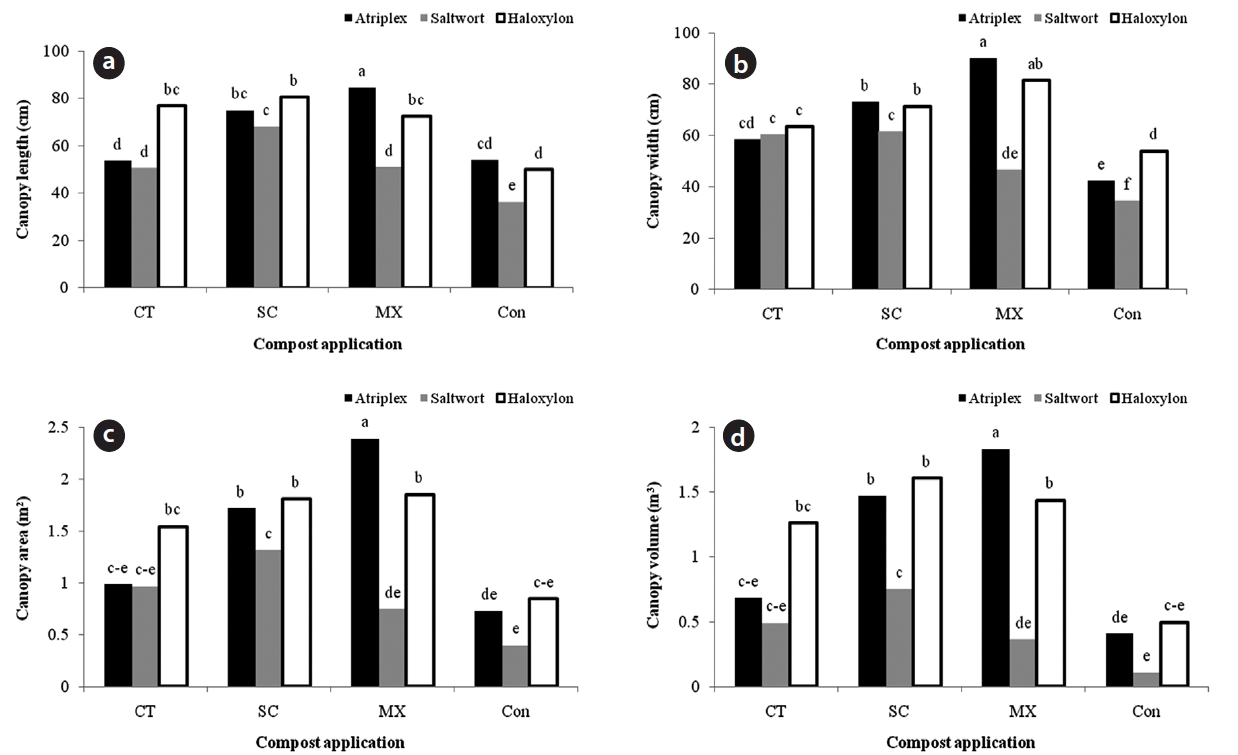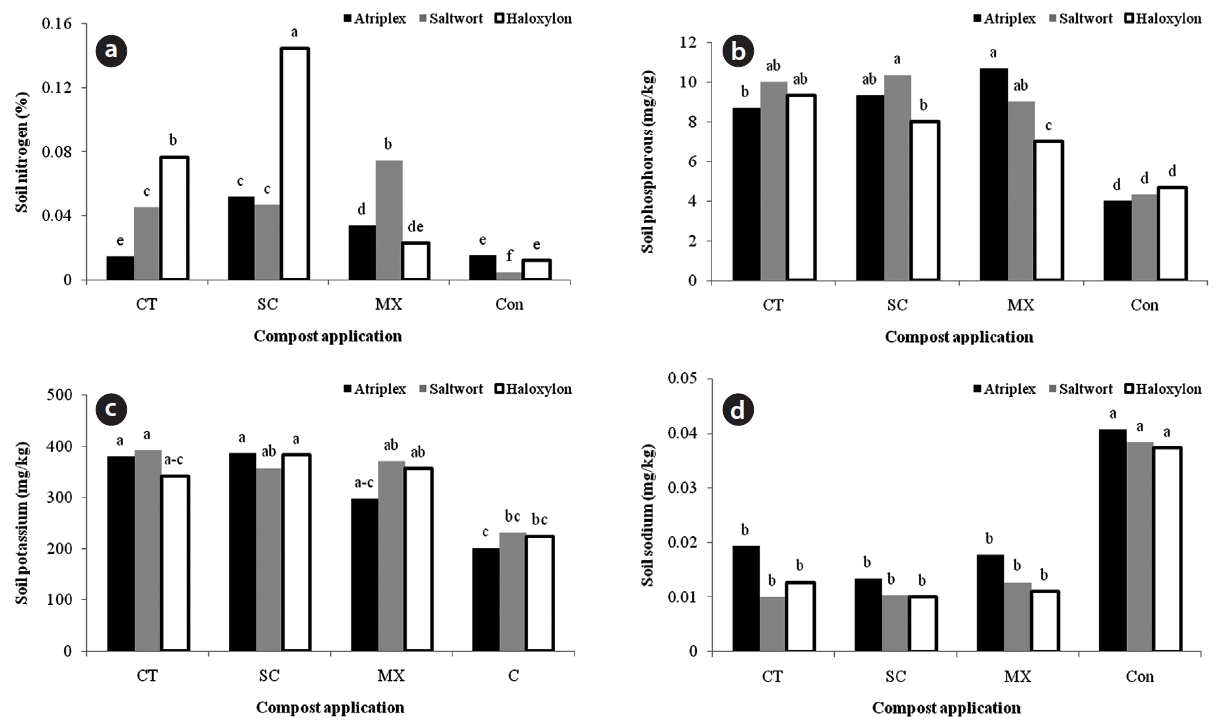



Atriplex (
The above species are tree rangeland species that are widely present and cultivated in dry land world pastures. In this situation, composting, which has beneficial effects on water maintenance, can be helpful. Compost has been widely used as soil conditioners and soil fertilizers. This practice has been recommended, since soil fertility needs to be sustained (Irvine et al. 2010).
Compost has several beneficial effects as a nutrient source for plant production and does not have deleteri-ous impacts on soil and plant (Hua et al. 2008). Compost contains many enzymes and hormones that can promote plant growth. The usefulness of different types of compost has been demonstrated and positive effects on the growth of crops have been reported such as wheat (Mantovia et al. 2005), barley (Renoux et al. 2007), rice (Rigi 2003), maize (Rezvantalab et al. 2008), sunflower (Anosheh et al. 2010), soybean, cowpea (Araujo et al. 2007), and lentil (Shahhos-seini et al. 2010). This effect was also reported for vegeta-tive plants, such as pepper, cauliflower (Casado-Vela et al. 2006), rapeseed and ryegrass (Renoux et al. 2007). Com-post also has a significant effect on soil properties. Several studies have documented the beneficial effects of the ap-plication of composting operation on several types of soil with proper amendment rate (Singh and Agrawal 2007). Also, it has been reported that composting can stabilize the organic matter and decrease the risks of heavy metals (Planquart et al. 1999).
This study was conducted to better understand how dry rangeland species, such as Atriplex (
A field study was carried out to examine the effects of different compost types on growth parameters of three dry rangeland species (Atriplex,
The study was a factorial experiment based on a ran-domized complete block design with 3 replications. Compost applications included compost tea (CT), solid compost (SC), MX and no compost as the control. De-scriptions of the CT and SC preparations are given in Table. 1 and 2, respectively. Amounts of compost used in each replication for CT and the SC treatments were 2 and 5 kg, respectively. Quantities were 2 kg CT and 5 kg SC for the mixed compost treatments, and the control treatment did not contain any compost.
Before the experiment was started, soil analysis was performed to determine soil properties. Soil samples were taken from a depth of 0-30 cm around the rhizosphere, using metal cylinders. The soil texture was sandy clay with pH 7.05, organic matter, electrical conductivity and total nitrogen 0.70%, 1.34 d/Sm, 0.06%, respectively.
At the end of the study, measurements were taken to assess morphological traits; plant height, stem diameter, plant volume, length, width and area of the plant crown. Plant height was measured from the soil’s surface to the highest free standing point of the crown. Crown length was measured at its widest point, and the lower crown di-ameter was measured as the width of a plant’s crown. The area of the plant crown was calculated using Eq. 1 (Bon-ham 1989):
CA = ? × r2 (1)
where
[Table 1.] Characteristics of the solid compost that was used in the ex-periment*

Characteristics of the solid compost that was used in the ex-periment*
[Table 2.] Characteristics of the liquid compost (compost tea) that was used in the experiment

Characteristics of the liquid compost (compost tea) that was used in the experiment
equal to 3.14159, and
where
PV = CA × h (3)
where
Data were subjected to analysis of variance (ANOVA) and significant differences between the treatment means

Statistical analysis of the morphological traits of arid region species subjected to different compost applications

Statistical analysis of the soil properties of arid region species subjected to different compost applications
were determined using the least significant difference test at
Results of ANOVA
Data analysis of variance showed that the compost had significant effects on plant height (1%), stem diameter (5%), length, width, area and volume of canopy (1% PL), illustrated in Table 3. The effect of compost application on all growth characteristics (i.e., plant height, stem diame-ter, length, width, area, and volume of canopy) was found to be statistically significant at the 1% or 5% PL. There was no significant effect on morphological traits for interac-tions, except on canopy volume (Table 3).
In relation to soil properties, plant species were signifi-cantly affected by soil nitrogen concentration at the 5% PL, and its effect on other soil traits was non-significant, as shown in Table 4. The effect of compost applications on soil organic matter (1% PL), soil nitrogen concentration (5% PL), and soil phosphorous amount (5% PL), soil po-tassium amount (5% PL) and soil sodium concentration (1% PL) was found to be statistically significant. Only soil nitrogen concentration was significantly affected by the interaction of compost with species (Table 4).
Correlation results
The correlation between the measured traits is shown in Table 5. All growth traits were positively correlated, but there was a significant correlation among some soil properties. Correlations among the growth traits and soil properties were different. Soil pH showed the low-est significant correlation and was correlated negatively with sodium (-0.171). However soil sodium concentration showed the highest significant correlation and was nega-tively correlated with all growth and soil traits.
[Table 5.] Correlation between measured traits for both growth characteristics and soil properties

Correlation between measured traits for both growth characteristics and soil properties
Plant height
Saltwort was a shorter plant (average, 45.75 cm) than Atriplex (average, 71.92 cm) and Haloxylon (average, 76.58 cm). This trend in all compost types was similar (Fig. 1). Compost application for any type of compost enhanced the plant height compared to the control treat-ment, and among composts, the CT had greatest effect on plant height. The effect of soil compost and mixed com-post were close together. Overall, the tallest plants grown in the experiment were Atriplex and Haloxylon in the SC treatment (Fig. 1a).
Stem diameter
The difference between stem diameter of Atriplex (av-erage, 2.3 cm) and Haloxylon (average, 2.1 cm) was non-
significant and higher than Saltwort (average, 1.6 cm). Compost significantly increased stem diameter of each species when compared to the control treatment. There was no significant difference among the three compost types (CT, 2.28 cm; SC, 2.29 cm; and MX, 2.00 cm). In this respect, CT was the most effective on Atriplex and Hal-oxylon and SC was the best treatment for Saltwort. The thickest stem was observed in Atriplex treated with the CT (Fig. 1b).
Canopy length and width
Atriplex and Haloxylon had higher canopy lengths (66.8 cm and 70.0 cm, respectively) and widths (65.9 cm and 67.5 cm, respectively) than Saltwort (51.5 cm and 50.8 cm, respectively). Plant canopy length and width was increased by compost application. The effect of CT on canopy length was higher than that for the other compost types, but in terms of canopy width, there were no signifi-cant differences among the compost types.
There were no significant differences between canopy length and width of plants treated with CT, but in other compost types, significant differences were observed (Fig. 2a and 2b). The better compost types for canopy length (Fig. 2a) and width (Fig. 2b) of Atriplex, Saltwort and Haloxylon were the mixed compost (MX), CT and mixed compost (MX), respectively. Atriplex had the highest can-opy length and width when treated with mixed compost (MX) when compared to other the compost treatments.
Canopy area and volume
Results of the effect of plant species and compost ap-plication on canopy area and volume were similar (Fig. 2c and 2d). Accordingly, higher canopy length and width were recorded in Atriplex and Haloxylon, which also had greater canopy areas (on average 1.4 m2 and 1.5 m2, re-spectively) and volume (on average 1.1 m3 and 1.2 m3, re-spectively) than Saltwort (on average 0.85 m2 and 0.42 m3, respectively). Compost application resulted in an increase in the area and volume of the canopy. In addition, mixed compost and SC had higher effects on canopy area (Fig. 2c) and volume (Fig. 2d), respectively, when compared to the others. Overall, the highest canopy area and volume was obtained in Atriplex treated with the mixed compost.
Soil pH
There were no significant differences among plants and composts, in terms of soil pH levels (Fig. 3a). On aver-age, the soil pH for all treatments ranged from 7.3 to 7.6.
Soil organic matter
Organic matter concentrations in the soil of all three species were similar and there was no significant differ-ence. Compost application could increase soil organic matter and the CT plots had higher organic matter con-centrations. There was no significant difference between the SC (on average, 3.0%) and the mixed compost (on average, 2.9%) compost type. The responses of the three plant species to compost type did not show a clear trend (Fig. 3b); nonetheless, the mixed compost was the most effective compost for Atriplex and Haloxylon and the SC was the most effective for Saltwort.
Soil nitrogen concentration
Haloxylon plots had higher soil nitrogen concentra-tions (on average, 0.064%) than Saltwort and Atriplex (av-erage, 0.042% and 0.028% respectively without significant difference). But the SC plots had higher nitrogen contents than the controls (plots without compost application) and nitrogen concentration in the other compost types was similar to the control treatment. The differences among the response of plant species to compost application were remarkable, where the responses of Atriplex and Haloxy-lon to the SC was high and the response of Saltwort to the mixed compost was high (Fig. 4a). Haloxylon treated with SC had exceptionally high nitrogen content.
Potassium and phosphorous concentrations
There were no significant differences between the plant species in terms of soil phosphorous and potassi-um concentrations. Compost application could increase phosphorous (on average, 9.1 mg/kg vs. 4.3 mg/kg) and potassium concentration (on average, 363.1 mg/kg vs. 218.7 mg/kg) of the soil, but no significant differences was observed among the types of compost. Effects of in-teraction of plant species with compost applications on soil nutrition were not significant (Table 4) as were the re-sponses of the three plant species to compost types (Fig. 4b and 4c). Differences between phosphorous concentra-tions (Fig. 4b) in the three plants as a result of compost application were higher compared to the results for po-tassium (Fig. 4c).
Soil sodium concentration
There were no significant differences between the three plant species in any of the compost levels in terms of soil sodium concentration (on average Atriplex, 0.028%; Salt-wort, 0.042%; Haloxylon, 0.064%). Compost application decreased sodium concentration in the soil when com-pared to the control treatments, but there were no sig-nificant differences between the three types of compost. The soil in all three treatments of plant species had higher sodium concentrations than the control treatments (Fig. 4d).
Atriplex were first planted in Iran to improve and de-velop the rangeland about 35 years ago (Tajali 2008). Hal-oxylon establishes and survives under extremely hostile conditions that are intolerant to other plant species (Rah-bar 1987).
In this study, the main effects of plant species and com-post application on all growth characteristics were signifi-cant and there was no significant interaction effect.
For all of the growth characteristics (as shown Table. 3 and 4), Atriplex and Haloxylon had higher values than Saltwort and there were no significant differences be-tween these two plants. The greater canopy recorded for Atriplex could be attributed to its shape and size. It is a spreading, communal shrub reaching more than three meters in height and generally more than that in width (Pearcy et al. 1977). Furthermore, Haloxylon is a hardy tree that can grow in nutritionally poor soil and can toler-ate drought (Huang 2000); so its growth is not restricted by hostile conditions. In contrast, Saltwort is a halophyte plant that is very well adapted to grow in dry and salty desert soil (Hadi 2009) and it has a low canopy that does not produce dense forage.
However, the composting operation increased the growth of all three species (see Figs. 1 and 2). The re-sponse of the plants to each of the tested compost types was similar, so for all plants, the results for growth (height) were highest (on average, 77.1 cm) and lowest (on aver-age, 47.0 cm) under solid composting and control con-ditions, respectively. The stem diameter of Atriplex and Haloxylon was higher when treated with CT but the most effective treatment for Saltwort was SC. In addition, the stem diameter of Atriplex and Haloxylon in all compost treatments increased when compared to the control. With respect to Eqs. 1 and 3, the canopy area and volume de-pended on canopy length and width. These results were in agreement with previous studies that reported enhanced the vegetative growth of Barley (
Responses of plants to different compost applications, in terms of canopy covering, were not similar, and the big-gest difference was demonstrated in CT. SC was the most effective treatment in regards to canopy length and width. Since compost application increases nitrogen availability (Inckel et al. 2005), this may be attributed to increased fo-liage due to plant growth. Furthermore, compost contains many nutrients that decompose and become available for plant use (Pattnaik and Reddy 2010). The effects of plant species on soil nitrogen concentration of compost application on organic matter, nitrogen concentration, phosphorous, potassium concentration and sodium con-centration of soil and the interaction effect of species and compost on soil nitrogen concentration was significant (Table 4). The soil pH level was unchanged when com-posting was used for all three plants, which was likely due to high soil buffering. The organic matter of plants treated with all types of compost was increased when compared to the controls. Organic matter is a key factor needed to improve the structure of soil. The highest organic matter was observed in CT for Atriplex and in SC for Saltwort and Haloxylon. There was no significant difference among the plants in the mixed compost (MX), in terms of organic matter.
Inckel et al. (2005) demonstrated that compost ap-plication could enhance the organic matter in soil. The study asserted that organic matter contains a substantial amount of nutrition important for plant growth, and these improve the water maintenance capacity of soil. Thus, it is possible that the compost treatments that had higher or-ganic matter contents improved plant performance and soil properties. Compost increased soil nutrition, that is to say nitrogen, phosphorous and potassium, but the variation in nitrogen concentrations was higher than in phosphorous and potassium. Another study reported that nutrient availability increased incrementally according to composting application (Soumare et al. 2002) and treated plants performed better when compared to the controls.
In terms of nitrogen, SC was recommended for use with Atriplex and Haloxylon and the mixed compost was the best for Saltwort. SC is ready for use after about six weeks. In terms of phosphorous and potassium, differences among compost types and plants were negligible. In this respect, Sundara et al. (2002), Soumare et al. (2002), Cavender et al. (2003), Jat and Ahlawat (2004) and many researchers hold the opinion that bio fertilizers, such as compost, improves soil characteristics and soil nutrition contents. The advantage of compost in terms of nutrition is that it facilitates the slow release of nutrients, which ex-tends the long term benefits of compost treatment (Inckel et al. 2005).
In contrast to all earlier studies, compost treatment was shown to decrease soil sodium concentration; neverthe-less this reduction also benefits plant growth. Because of the high levels of sodium in the soil solution, a plant’s ability to uptake water is limited due to decreased soil water holding potential (Subbarao et al. 2003); therefore, this might cause plants to wilt. There were no significant differences among all treatments, except the three plants that were grown in the controls. Although there are ni-trogen, sodium, chlorides, and sulfate salts present in SC (Zhang et al. 1998), the amount of sodium was lower than the amount of the other elements. Higher soil sodium within the cytoplasm of the cells can lead to enzyme in-hibition, which may result in symptoms such as necrosis, chlorosis, and possible plant death (Pessarakli 2001). So, compost application could be used to combat the de-structive and harmful effects of sodium in soil.
These results demonstrate that compost application in soils, especially soil compost, was an effective method to supply nutritions for plant growth. Compost is used in combination with chemical fertilizers in advanced ag-ricultural systems. Finally, from the results of this study it can be recommended that the best compost applica-tion to increase growth and improve soil conditions were mixed compost (MX) for Atriplex and SC for Saltwort and Haloxylon.








